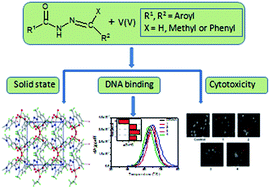Oxidovanadium(v) complexes of aroylhydrazones incorporating heterocycles: synthesis, characterization and study of DNA binding, photo-induced DNA cleavage and cytotoxic activities†
Abstract
Four neutral oxidovanadium(V) complexes VO2L1 (1), VO2L2 (2), VOL3(OEt) (3) and VOL4(OEt)EtOH (4) [where HL1 = 2-thiophenoylhydrazone of 2-acetylpyridine, HL2 = 2-amino benzoylhydrazone of 2-benzoyl pyridine, H2L3 = isonicotinoylhydrazone of 2-hydroxy acetophenone, H2L4 = 2-furoylhydrazone of 2-hydroxy-1-napthaldehyde] with a hydrazone scaffold containing either furan, thiophene and pyridine residues have been synthesised. All complexes were thoroughly characterized by various spectroscopic (IR, UV-Vis, NMR and ESI-MS) and single crystal X-ray diffraction techniques. Crystallography establishes five-coordinate geometries, distorted toward square pyramidal for each of 1 and 2, based on a tridentate-O,N,N coordinating anion and two oxido-O atoms. The dianion in 3 is tetradentate, coordinating one V atom as for 1 and 2, and bridging another via the pyridyl-N atom, and the N2O4 octahedral coordination geometry is completed by oxido- and ethanolate-O atoms. The result of the V–N bridging is a helical coordination polymer. An NO5 octahedral geometry is found in 4 defined by a tridentate-O,N,O anion, as well as oxido-, ethanolate- and ethanol-O atoms. Biological studies reveal that 1–4 have DNA binding propensity and show these to interact with CT-DNA through the minor groove binding mode, with binding constants ranging from 103 to 105 M−1. All complexes show good photo-induced cleavage of pUC19 supercoiled plasmid DNA with 3 showing the highest photo-induced DNA cleavage activity of ∼65%. Additionally, 1–4 are cytotoxic against the human cervical cancer cell line (HeLa) with IC50 values ranging from 10 to 20 μM.


 Please wait while we load your content...
Please wait while we load your content...